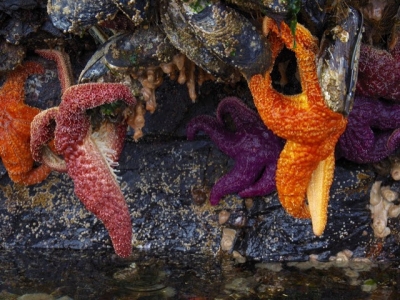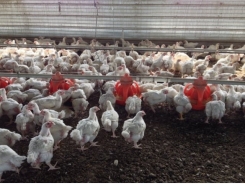Will blue protein plug the gap in organic pig and poultry production?

'Common to all the new protein sources, though, is this issue of price; they can’t compete currently, but the research focus is on the development of these new sources to meet future feed requirements.' © istock/DanielLacy
Organic pig and poultry producers in Europe face a lack of organic protein sources. Mussels and starfish may fit well as future feedstuffs for that segment but there are challenges around processing such raw materials into meal.
Jan Værum Nørgaard, associate professor in the Department of Animal Science at Denmark’s Aarhus University, presented on this subject at Victam 2017 in Cologne.
He is involved in various research projects on alternative proteins at the university.
The researchers there are evaluating the nutritional benefits and the technical aspects linked to the production of protein meal of mealworms as well as their direct consumption, along with exploration of the potential of green proteins such as extract from clover grass, and blue proteins including mussel and starfish meal and seaweed. They are also weighing up the pros and cons of microbial biomass.
Nørgaard said it is slightly easier to get capital now for such lines of investigation, with alternative protein sources seen as a growing societal need. We caught up with him to hear more.
Blue protein
“It has taken us nearly nine years to get funding for the mussel research project. We finally got seed money from the Innovation Fund Denmark, so the work got underway in January this year.”
The €3m backed mussel research will span four years; it is aimed at finding protein sources for the organic pig and poultry feed sector in Denmark, in particular, he added.
He said the production of mussel meal in the Danish fjords is potentially 15,000 tons of de-shelled dry mussel meal per year. An experiment in a Danish inland fjord using a mussel farm on 18 hectare showed an annual production of 61 tons fresh mussels per hectare.
“You cannot compare the volumes to fishmeal production.”
Mussels grow well in the Baltic Sea all the way down to the coast of France, he explained.
Blue mussels can be harvested year round but preferably before winter to avoid risk of ice coverage. The farms should be in nutrient-rich water of a quality of a standard to meet the EU regulations for mussel farming, he said.
Mussel meal, he said, is characterized by a crude protein content of 58-66% in dry matter, a low mineral concentration, and for pigs and poultry, a balanced amino acid profile.
The crude fat content of 12-16% in dry matter includes a relatively large amount of polyunsaturated fatty acids and especially the omega-3 fatty acids eicosapentaenoic (EPA) and docosahexaenoic (DHA) (Nørgaard et al., 2015; Passi et al., 2002). Mussels also contain carotenoids, such as β-caroten, lutein A, zeaxanthin, and xanthofyls like astaxanthin (Jönsson, 2009). The ileal digestibility of crude protein in pigs is 0.83 (Nørgaard et al., 2015).
Processing
Getting rid of the shells is one of the main meal production hurdles in relation to blue mussels, he said.
When used for pig feed, the meat should be separated from the shell fraction, but there may be a potential use of ashell-containing mussel product for poultry. “Removal of shells can efficiently be done by boiling, a well-known process in the production of mussels for human consumption. However, the boiling process is costly, and there is risk of nutrient loss.”
The group is also looking at other separation technology under the auspices of the project, with industrial partners signed up to the initiative, but those companies, have until now, been involved in producing mussels for human consumption. “Essentially, it is about refining that technology, finding an efficient way to process mussel meal,” said
“Other processing methods to remove shells can be based on physical separation by e.g. sedimentation of crushed fresh mussels or screw pressing of the fresh mussels, enzymatic processes, or by dry fractionation. In Sweden, work on processing blue mussels into meal has resulted in a patent on separation of meat and shells by a temperature mediated hydrolysis (Lindahl, 2013).”
Starfish protein
Nørgaard said the university’s starfish meal research project has only one more year to run. It has been going since 2014, with a number of studies published in that time.
Starfish meal would be somewhat limted in scale compared to other protein sources but could be used in niche, high value sectors, he said.
Starfish are characterized by a crude protein concentration in the range of 38-70% and an ash concentration of 20-42% in dry matter depending on season, said the researcher.
The highest concentration of crude protein and the lowest concentration of ash is found in February. The ash is not sand but a high concentration of calcium.
The concentration of fat is 9-11% in dry matter and polyunsaturated fatty acids are found (Holtegaard et al., 2008; Nørgaard et al., 2015). The standardized ileal digestibility of crude protein in starfish meal is 0.80 (Nørgaard et al., 2015), he said.
Nørgaard and the team carried out a feeding trial with piglets, using starfish meal (SM) containing 961g dry matter and 368g crude protein per kg.
Their study suggested that feeding 9kg pigs 50g SM/kg resulted in gain and feed intake equivalent to fishmeal. However, feeding 100g SM/kg caused the same feed intake but lower gain than with other diets. The plasma concentrations of Ca were higher and of P lower in pigs fed 100g of SM/d. The researchers concluded the maximum SM inclusion level might be dictated by its Ca concentration (Nørgaard et al., 2016).
Starfish meal production
Starfish can be dried and ground at a fishmeal factory; currently this is the most efficient processing method, he said.
“Starfish are easy to handle at fish meal factories, but it may be difficult to process starfish at such facilities because of low tonnage and a fishing season overlapping with the traditional fishery, given that starfish and needs to be processed on a separate line.
“Therefore, alternative processing methods may be relevant. However, the physical characteristics of starfish makes them difficult to handle when they are minced using, for example, a screw press. Such a process could produce a protein rich liquid fraction for use in liquid pig feeding and a dry pulp fraction to be used as fertilizer.”
Mealworms
The Danish researchers have also secured funding to understand how to fully automate mealworm production and to evaluate their benefits for food along with the piglet and chicken feed sectors.
Targeting mealworms as a retail ready food gives producers a high return. “Companies can get €500 per kilo of mealworms freeze dried for human consumption. A more cost effective drying technique such as acid hydrolysis or extrusion is needed to make mealworms competitive for use in feed,” he said.
The fat fraction of mealworms – around 30% - also provides grinding challenges. “Work is going on in relation to extruding the fat.”
Related news
Tools

Phối trộn thức ăn chăn nuôi

Pha dung dịch thủy canh

Định mức cho tôm ăn

Phối trộn phân bón NPK

Xác định tỷ lệ tôm sống

Chuyển đổi đơn vị phân bón

Xác định công suất sục khí

Chuyển đổi đơn vị tôm

Tính diện tích nhà kính

Tính thể tích ao



 Tannic acid feed supplement may reduce footpad dermatitis…
Tannic acid feed supplement may reduce footpad dermatitis…  Stimulating feed intake should be the focus of…
Stimulating feed intake should be the focus of…